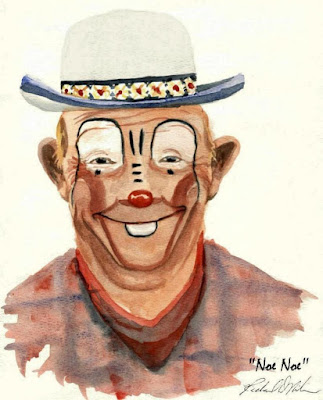Monday, April 18, 2016
Sunday, April 17, 2016
ICHOF: Foolish Fundraiser
"Let us be thankful for the fools. But for them the rest of us could not succeed"- Mark Twain
Titled, "The Pit Stop", it features Lou Jacobs, Otto Griebling, Red Skelton, Emmett Kelly, Felix Adler and Mark Anthony. These are limited edition high quality poster prints.
Friday, April 15, 2016
Thursday, April 14, 2016
Wednesday, April 13, 2016
Tuesday, April 12, 2016
Monday, April 11, 2016
Sunday, April 10, 2016
OTTO GRIEBLING: Cole Bros. Circus (August 25th 1937)
Friday, April 01, 2016
INTERNATIONAL CLOWN HALL OF FAME: APRIL'S "FOOLISH FUNDRAISER From Director Greg DeSanto
"Let us be thankful for the fools. But for them the rest of us could not succeed"- Mark Twain
Six years ago today a great friend of the ICHOF, and Board member, Sandy Weber designed this wonderful logo as we moved forward to re-opening this little place where clowns are celebrated, stories are remembered and lives dedicated to laughter are shared with old and new generations.
We we opened our doors to the public on May 21, 2010 in our new home of Baraboo, Wisconsin. since that date we have had thousands of guests visit us in person and view the most amazing collection of clown artifacts in the world. We hope they leave with a smile & respect for this art form and share our mission with their family and friends. Our presence on social media has allowed us to bring images and information to potentially millions of people world wide who appreciate clowning as the craft that it is, respect those individuals who's careers have elevated laughter to the most needed medicine for what ails us as a human race, and inspires those who are looking to fufill the calling in their life called clowning.
How perfect the timing that a museum that honors the humor in our lives began on this day known to our society as April Fools Day.
With that, the Board of Directors of the International Clown Hall of Fame and Research Center is proud to announce a "FOOLISH FUNDRAISER" to begin today April 1, 2016 and conclude on the Anniversary day of our opening in Baraboo, Wi, May 21, 2016.
Our goal is for us to raise $10,000 in the next 51 days.
Our 2016 plans include adding substantially to our artifact collections, digitizing and making avaiable online our vast photo archives, the transfer to digital dvd of thousands of feet of rare movie films, new display fabrications and continuation of our Oral Histories project. These goals can only be met with your help.
We will be including incentives to those who can help us reach this attainable dream. Please visit our website at www.theclownmuseum.com where a link to PayPal is located. For today, April 1,2016, in honor of this day celebrating fools, anyone donating $100.00 to $200.00 will recieve a limited edition Jim Howle poster honoring the very first 5 Inductees into the International Clown Hall of Fame.
Titled, "The Pit Stop", it features Lou Jacobs, Otto Griebling, Red Skelton, Emmett Kelly, Felix Adler and Mark Anthony. These are limited edition high quality poster prints.
Every day between today and May 21,2016, the ICHOF will offer an incentive and grateful thank you to those who can donate and help preserve our shared clown heritage. Check back here and on our webpage daily for a suprise and a sharing of clowns worldwide!
Saturday, March 26, 2016
Friday, March 25, 2016
Thursday, March 24, 2016
CLOWN CARS: Billboard Magazine (November 13, 1948)
1948 being the end of Lou Jacobs' first full season of performing his routine.
An earlier "midget auto" built by Leo McKenzie (whose family owned the Wichita Carriage Works)...
Title/Object Name: McKenzie Midget Auto
Creator: Unknown photographer
Date Original: Circa 1930
Physical Details: 4 x 3 inches
Description: Group of boys gathered around a miniature automobile built by Leo L. McKenzie. The clown in the driver’s seat and the flags may indicate they are about to participate in a parade. McKenzie built and sold these small cars as a sideline to his business, McKenzie Body Works.
Keywords: Business and industry, children, people, transportation, Wichita.
Subject: Wichita (Kan.) -- Pictorial works
Type: Photographic Contact Print
Collection Name:
Repository: Wichita-Sedgwick County Historical Museum
Date Digital: 2003
Identifier: wschm_T3-34.1.8
|
Mr. McKenzie passed away on January 30, 1977 at the age of 90 in Wichita, KS.
Wednesday, March 23, 2016
AL MIACO: Obituary, NY Clipper (July 27, 1923)
A grandson, Al Renton, is perpetuating the name by appearing as a clown . The funeral services were held Monday and were attended by hundreds of circus people.
Tuesday, March 22, 2016
CLOWN ALLEY: "The B.B. Club", Ringling Bros. Circus (circa 1900)
"B.B. Club" was a common newspaper abbreviation for baseball team at the turn of the century.
All the performers listed are clowns so some of the clowns either had their own

















































